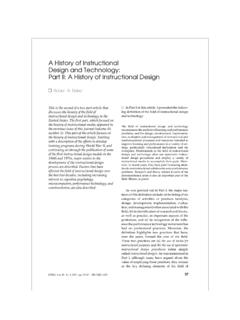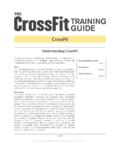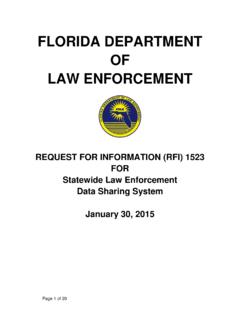Transcription of Instructional Design Tools: A Critique and …
1 Instructional Design Tools: A Critique andProjections for the FutureKent GustafsonThis article critiques the Instructional designtools described in the special issue ofEducational Technology Research andDevelopment, Volume 50 Number 4, Computer-Based Tools for InstructionalDesign. Although focusing on four tools,(a) digital management systems, (b) CASCADE, (c) knowledge managementsystems, and (d) ADAPTIT, the author alsocomments on the introductory article (vanMerri nboer and Martens), and compares thefour described tools with earlier this Critique primarily focuses onthe four described tools (a) digital manage-ment systems, (b) CASCADE, (c) knowledgemanagement systems, and (d) ADAPTIT a fewcomments seem in order about the introductoryarticle by van Merri nboer and Martens.
2 Theircomments about a new view of learning seema bit overstated. For many years a variety oflearning theorists have described and docu-mented the benefits of designing rich, multi-disciplinary and collaborative learningenvironments. Recently, constructivists andothers have been vocal and active in their effortsto incorporate these features. But the value ofdoing so (appropriately of course) has a longand honorable history going back at least as faras Dewey. Likewise, the value of authenticity,achieved via a variety of methods including casestudies, field trips, simulations and games, andinternships also has been widely recognized formany years, if not always practiced.
3 What thenew forms of technology have added is theability to more readily incorporate these authen-tic features in the the Design process is nonlinear isanother point the authors seem to claim is arecent discovery. Numerous early models in-cluding those by Barson (1967), Kemp (1985),and Briggs, Gustafson, and Tillman (1991) haveemphasized the nonlinearity of the Walter Dick (Dick & Carey, 1996) believesthis is often the case even though this widely cir-culated model is introduced in his text in asimplified and linear form. I agree completelywith van Merri nboer and Martens that inmany, but not all, situations, the Design processin nonlinear. Further, that there is increased in-terest in nonlinear Design processes is clearlyevident.
4 However, I do not agree that this repre-ETR&D, Vol. 50, No. 4, 2002, pp. 59 66 ISSN 1042 162959 AAH GRAPHICS, INC. / (540) 933-6210 / FAX 933-6523 / 11-26-2002 / 14:40sents a recent discovery. Again, recent advancesin technology make it much easier to applytraditional Instructional Design (ID) models andother nonlinear Design methods such as rapidprototyping. But easier application and in-creased interest in nonlinear Design are not thesame as saying it is newly a prelude to discussing the four articles inthis issue that describe ID tools, several cautionsare in order. One that immediately comes tomind is derived from a comment my wisemother made to me early in life when she said, to a child with a hammer all the world lookslike a nail.
5 Instructional designers may sufferfrom this perspective when they look at the toolsdescribed in these articles and immediatelywant to apply them to their own unique is important to remember that, with the excep-tion of the Spector article, each describes a toolthat is only appropriate for a specific nail andmust be judged accordingly. The second cautionis illustrated by a comment reportedly made byHenry Ford who, when asked if his widelypopular Model T automobile was fool proofresponded, yes, but not damn fool proof. Thusthe caution that even good tools require applica-tion by informed and intelligent users if thedesired results are to be achieved. The degree ofboth general and specific ID and subject matterexpertise expected of tool users is a central factorwhen considering its application.
6 The reminderthat judgment is no better than the available in-formation prompts a third caution. This authorhas personally examined only one of the tools(CASCADE) in only two of its versions. Nonehas been completely tested in terms of benefitsto learners. Although the lack of such learnerperformance data is understandable because thetools reviewed are still in prototype form, in thefuture it will be essential to the credibility of theentire ID tools movement that such data be sys-tematically collected by all tool this review most of my comments arebased solely on the articles themselves, whichfor a variety of reasons provide only limiteddetails and no feel for the actual functioning ofthe tools.
7 And finally a comment regardingprognosticating about the future direction of IDtool development. Only weather forecasters,charlatans, and fools confidently predict the fu-ture. Nonetheless some thoughts are providedand you are left to decide in which category thisauthor falls. Having said all this, I now turn toconsidering the FUNCTIONSID has been defined in a variety of ways, but theacronym ADDIE (analysis, Design , develop-ment, implementation, and evaluation) servesmy purposes. All five of these activities are re-quired if one is to produce effective instructionthat is assured to meet specific needs. How thesefive activities are best conducted is a matter ofmuch debate and some disagreement, butanyone short of being a radical constructivistagrees all are necessary in some form.
8 Thus, onecriterion for examining and characterizing an IDtool is to ask how many of the five ADDIE ac-tivities it contains. A second criterion is to ex-amine the underlying philosophic andtheoretical underpinnings (often unstated) of thetools for, unlike the trusty hammer; all ID toolsdo have such accompanying s description of generic tools forknowledge management does not specificallyaddress any of the ADDIE activities, butpresumably can be used to facilitate all of , the designers and other stakeholders pro-vide virtually all content and process decisionsand actions, and the philosophic and theoreticalperspective for the project. Although thesegeneric tools are highly flexible, they provide nouseful substantive guidance or assistance to en-hance the quality of the output.
9 All such struc-ture and content is provided by users. Theymay, however, add to quality by promotingteam collaboration, and to efficiency throughstructured document control. Mooij describesone digital management system called the Digi-tal Planning Board (DPB) that does not providedirect substantive assistance to Design teams,but does facilitate their collaboration andmanagement of the learning kernels one ofits central features. The DPB appears rooted inconstructivist and social learning theories, butalso has close ties to mastery learning (Bloom,1968) and its emphasis on identifying discreteknowledge and skill competencies that can besequenced and GRAPHICS, INC. / (540) 933-6210 / FAX 933-6523 / 11-26-2002 / 14:4060 ETR&D, Vol.
10 50, No. 4 ADAPTIT tools assist with analysis, designand evaluation in the limited domain of complexcognitive skills. A to-be-developed tool (TASKi)has the ambitious goal of intelligently support-ing personalized delivery of training. Addinginstructional delivery capability to ID tools iscertainly an appealing concept and would en-hance their potential for implementation, whichremains a chronic problem. However, earlier ef-forts of others have not met with great success,and I will watch for evidence of their progresswith great interest. ADAPTIT s theory andphilosophy appear to be somewhat eclectic. Theanalysis element seem to be grounded in be-haviorism and cognitivism in the sense that the4C/ID* model assumes complex skills can beanalyzed into their subcomponents, sequenced,and then taught in part- and whole-task , the instruction element seems to bebased largely in constructivism, in the sense ofschema building by learners.








